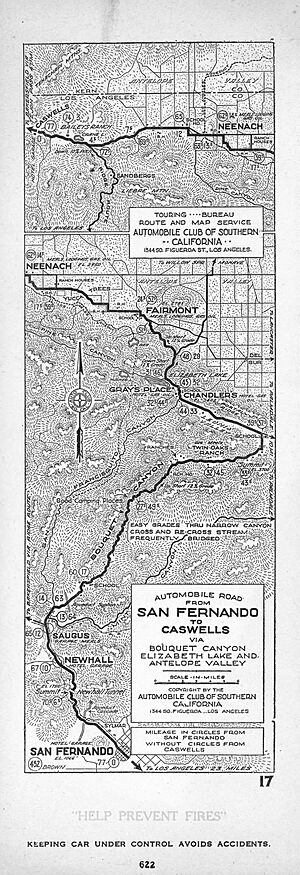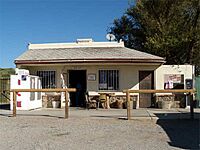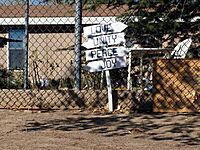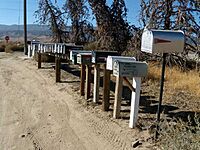Neenach, California facts for kids
Quick facts for kids
Neenach, California
|
|
|---|---|

Automobile road from San Fernando to Caswells via Bouquet Canyon, Elizabeth Lake and Antelope Valley, 1922
|
|

Location of Neenach in Los Angeles County, California
|
|
| Country | |
| State | |
| County | Los Angeles |
| Elevation | 901 m (2,956 ft) |
| Time zone | UTC-8 (Pacific (PST)) |
| • Summer (DST) | UTC-7 (PDT) |
| ZIP Code |
93536
|
| Area code(s) | 661 |
| GNIS feature ID | 1669887 |
Neenach (pronounced NEE-nak) is a small farming community in the northwestern part of Los Angeles County, California. About 800 people live there. This area is seeing big changes because a huge new community called Centennial is planned to be built nearby.
Contents
Geography and Climate
Neenach is located about 34 miles (55 km) northwest of Lancaster. It is in the Antelope Valley area of Southern California. The community is also 15 miles (24 km) southeast of Gorman. It sits north of the Sierra Pelona Mountains. The weather here is usually hot and dry in the summer.
History of Neenach
Early Names of the Area
The original name for the place where Neenach now stands was puyutsiwamǝŋ. This name comes from the Kitanemuk language. The Spanish explorers later called it Ojo de la Vaca, which means "Cow's Eye" or "Cow Spring".
Cow Springs and French John's Station
In the 1800s, this area was known as Cow Springs. It was about a mile southwest of where Neenach School is today. An old road called El Camino Viejo passed through here. This road was used by travelers going to Los Angeles.
Later, a shorter route was used by the Butterfield Overland Mail stagecoach line. This route connected Elizabeth Lake and Gorman. French John's Station was a stop for stagecoaches and travelers. It was about 14 miles (23 km) east of Gorman, near Cow Springs.
In 1888, Cow Springs was described as a nice place to camp. It had willow trees that offered shade. There was also a "pure, cold, clear stream" that flowed from the ground.
How Neenach Was Established
Neenach was founded in the 1870s by Danish settlers. They came from a town called Neenah, Wisconsin. In 1888, a post office was opened in Neenach. John A. Coovert was the first postmaster. Later, in 1905, Christian Clausen became the postmaster.
James Anderson was an early settler who claimed land here in 1887. His land was near where State Route 138 and 300th Street West are today. He also had a job to fix and improve roads in the Antelope Valley.
The Los Angeles Aqueduct
The building of the Los Angeles Aqueduct was very important for Neenach. This huge project happened between 1905 and 1913. The aqueduct brought water all the way from the distant Owens Valley to the San Fernando Valley.
James Anderson, the early settler, became a patrolman for the aqueduct. He had to check the aqueduct regularly to make sure it was working well. Another resident, Harry Womersley, also worked on building the aqueduct.
Gold Discovery
In the early 1930s, gold was found in the hills south of Neenach. One mine, called "Oh Suzanna," produced a lot of gold. Some reports say it produced about $7 million worth of gold. Other accounts say the total gold from the Neenach mining area was about $200,000.
In the 1970s, Neenach was a lively place. People had community potluck dinners. The local 4-H Club had almost 80 members. However, many young people moved away from the area as they grew up.
Proposed Development
There are plans for a very large new community near Neenach. It is called Centennial and would be built on part of Tejon Ranch. This planned community could have 23,000 homes.
The plans include town squares, parks, shops, and three fire stations. Children would be able to walk to one of the eight elementary schools. The people behind the project say it would create 30,000 local jobs. They plan to build a new house every eight hours for 20 years!
However, some groups are against this project. The Center for Biological Diversity says Centennial would be built on rare ecosystems. This includes one of the largest natural grasslands left in California.
Services in Neenach
Library Services
The Los Angeles County Library has a bookmobile that visits Neenach. It stops at the Neenach market on Saturdays from 11 AM to noon.
Schools in Neenach
The current Neenach School building opened in 1993. It replaced an older building that had been there for many years. The school closed in 2001. This was because fewer children lived in the area. Also, heating costs were very high since the school used only electricity. The year before it closed, 66 students were enrolled.
Neenach is part of the Westside Union School District. This district also runs several other schools in West Lancaster. These schools teach students up to the eighth grade. After eighth grade, students go to high school in the Antelope Valley Union High School District. They can also attend college in the Antelope Valley Community College District.
Natural Wonders
Volcanic Formations
The Neenach Volcanic Formations are very old, about 23.5 million years old. They are made of igneous intrusions, which are rocks formed from cooled magma. These formations are near Old Post Road, close to Interstate 5 and Gorman, California.
Over millions of years, plate movement along the San Andreas Fault split these formations. Half of them moved about 200 miles (320 km) north. They are now part of Pinnacles National Park.
The Neenach Meteorite
The Neenach Meteorite is a 30-pound (13.6 kg) stony chondrite meteorite. It was found in April 1948 by Elden Snyder of Neenach. He found it with his plow, which broke it into four pieces. In 1952, it was shown to Robert Wallace Webb at the University of California, Santa Barbara. Later, it was given to the collection at the University of California, Los Angeles.
Communication
The ZIP Code for Neenach is 93536. Mail is handled by the Lancaster post office. The telephone system uses area code 661.
Gallery
Additional Reading
- "Distance From San Francisco to St. Louis: From Station to Station," The Semi-Weekly Southern News, February 6, 1861, page 4 This article lists Cow Springs as a settlement.
- "On His Own Domain," San Francisco Examiner, July 28, 1888, page 1 This article mentions Cow Springs as a resting place.











